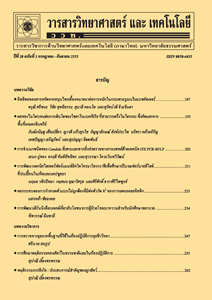การจำลองผลประหยัดค่าไฟฟ้าจากการเปลี่ยนมาใช้ค่าไฟฟ้าแบบอัตราตามช่วงเวลาของการใช้ (TOU)
Main Article Content
Abstract
Abstract
This article aims to propose the electricity cost saving chart by changing from time of day (TOD) to time of use (TOU) for all electricity tariff rates. The study was based on electricity tariff rate (2015) of the provincial electricity authority (PEA). According to the research, the electricity cost saving depends on the electrical energy consumption behavior such as total energy consumption (kWhTotal), electricity energy ratio (kWhP/kWhTotal) in peak time, and Load Factor as well as demand ratio (PPeak/P) relying on rate type. The customer can use this chart as the guidelines which changing to TOU rate by analyzing their own electrical usage behavior parameter. In addition, the chart is plotted to evaluate the percentage of energy saving. The customer can change to use the TOU rate, if they qualify these conditions. To illustrate, for residential customer at voltage level 22-33 kV must have an electricity energy ratio in peak time less than 0.7. For residential customer at voltage level is lower than 22 kV and small general service customer must have an electricity energy ratio in peak time less than 0.52. For medium general service customer at voltage 22-33 kV level which have an electricity energy ratio in peak time less than 0.4 or load factor less than 0.08 can change to use the TOU rate immediately. Additionally, for non-profit organization customer at voltage level 22-33 kV must have an electricity energy ratio in peak time less than 0.55. A non-profit organization customer at voltage level lower than 22 kV must have an electricity energy ratio in peak time less than 0.65. Finally, agricultural pumping customer must have an electricity energy ratio in peak time less than 0.4.
Keywords: TOU rate; change electric rate; electricity cost saving
Article Details
References
[2] ศูนย์ข้อมูล & ข่าวสืบสวนเพื่อสิทธิพลเมือง TCIJ, ค่าไฟฟ้าอัตรา TOU ลดวิกฤตช่วงพีคได้ ทำไมการไฟฟ้าฯ ซ่อนไว้ใต้พรม, แหล่งที่มา : https://www.tcijthai.com/news/2016/07/scoop/6294, 20 เมษายน 2560.
[3] เอกรินทร์ วัชรยิ่งยง, 2548, การเปรียบเทียบค่าใช้ไฟฟ้าประเภทบ้านอยู่อาศัย : กรณีอัตราค่าไฟฟ้าตามช่วงเวลาของการใช้กับกรณีอัตราค่าไฟฟ้าปกติ, การศึกษาค้นคว้าอิสระปริญญาโท, มหาวิทยาลัยเกษตรศาสตร์, กรุงเทพฯ, 106 น.
[4] นพรัตน์ เกตุขาว และวิชญ์พล ฟักแก้ว, 2562, การจัดการใช้ไฟฟ้าในกลุ่มตัวอย่างศึกษาสำหรับโรงสีข้าว โรงแรม และโรงน้ำแข็ง, ว.วิชาการพระจอมเกล้าพระนครเหนือ 29(4): (ตอบรับตีพิมพ์).
[5] กรมพัฒนาพลังงานทดแทนและอนุรักษ์พลังงาน, 2559, เอกสารเผยแพร่เพื่อการอนุรักษ์พลังงานชุด : การจัดการการใช้พลังงานไฟฟ้า, 50 น.
[6] Power Planet - Electrical Management Systems, Electrical Load Factor, Available Source: http://www.demandcharge.com/Web_Pages/Articles/Electrical_Load_Factor.html, April 1, 2018.
[7] สุพร กุลวัฒนันท์ชัย, 2551, เอกสารประกอบการอบรม : กิจกรรมการจัดการพลังงานแบบสมบูรณ์ เพื่อยกระดับประสิทธิภาพการใช้พลังงานสำหรับอุตสาหกรรม รุ่นที่ 8, กรมส่งเสริมอุตสาหกรรม, 56 น.
[8] การไฟฟ้าส่วนภูมิภาค จังหวัดพะเยา, สัมภาษณ์, 15 พฤศจิกายน 2560.
[9] การไฟฟ้าส่วนภูมิภาค, โครงสร้างอัตราค่าไฟฟ้า ปี 2558, แหล่งที่มา : https://w3c.pea.co.th/Portals/_default/Documents/Rate2015.pdf; 2559, 20 กันยายน 2560.


